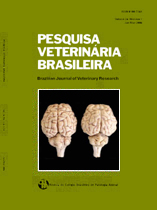 |
|
|
|
Year 2011 - Volume 31, Number 11
|

|
Comparison between the clinical and pathological picture in the experimental poisoning by crotalic venom, 31(11):967-973
|
ABSTRACT.- Barbosa J.D., Sousa M.G.S., Tokarnia C.H., Brito M.F., Belo Reis A.S., Bomjardim H.A., Lopes C.T.A. & Oliveira C.M.C. 2011. [Comparison between the clinical and pathological picture in the experimental poisoning by crotalic venom.] Quadro clínico-patológico do envenenamento crotálico experimental em bubalinos comparado com o de bovinos. Pesquisa Veterinária Brasileira 31(11):967-973. Central de Diagnóstico Veterinário, Universidade Federal do Pará, Rua Maximino Porpino da Silva 1000, Pirapora, Castanhal, PA 68743-080, Brazil. E-mail: diomedes@ufpa.br
The objective of the study was to verify the sensibility of buffaloes to the poison of Crotalus durissus terrificus and to study the clinical-pathological picture in buffaloes in comparison with the one in cattle. The subcutaneous inoculation of the liofilized poison of the snake, diluted in 1ml of physiologic solution, was done in the area of the humerus-radio-ulnar joint of three buffaloes at doses of 0.015, 0.03 and 0.066mg/kg, and of two cattle at doses of 0.03 and 0.066mg/kg. The buffalo that received the 0.03mg/kg dose presented severe clinical signs but recovered six days later. The bovine that received the same dose, died after a clinical course of 22h56min. The 0.066mg/kg dose caused death of the bovine as also the buffalo, with a clinical course of 4h23min and 8h12min, respectively. The buffalo that received the 0.015mg/kg dose recovered, after a course of 48 hours. The buffalo that died, showed clinical signs from 3h58min on, and the buffaloes that showed symptoms from 17h25min and 24h00min after inoculation of the venom, but recovered. In the two cattle that died (with doses of 0.03 and 0.066mg/kg), the first clinical signs occurred 6h10min and 6h31min after the inoculation of the venom. The inoculation produced in the buffaloes and cattle nervous symptoms of flaccid paralysis. The main signs observed in the buffaloes as well as the cattle, were slight volume increase at the site of inoculation, respiration difficulties characterized by predominantly abdominal breathing, apathy, sialorreia, difficulty to get up when stimulated, evolution to sternal decubitus followed by lateral decubitus with peddling movements of the legs, and decrease of the reflexes related to the cranial nerves. The buffaloes showed also augmentation of the sustentation base, dragging of the hooves of the hind legs, slow and staggering gait, difficulty in apprehension of the food, The cattle showed additionally paralysis of the eyeballs, revealed through non-exhibition of the sclera during head rotation in latero-caudal direction. Laboratory exams revealed in the cattle and the buffaloes leucocytosis by neutrofilia, and in the biochemistry series, increase in the levels of alanine aminotransferase, aspartato aminotransferase, creatinaquinase and lactic dehydrogenase. There was no alteration in the urinalysis nor in the activation time of protrombine and in the time of partially activated tromboplastin. Necropsy only evidenced slight edema corresponding to the inoculation site in one bovine. Histopathological examination revealed picnosis of the epitelial cell nuclei of some kidney tubules in the cortex (in the buffalo and in one bovine) and slight vacuolation of hepatocites (in one bovine). |
| |
|
|
| |
|
 |